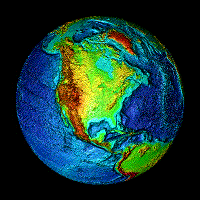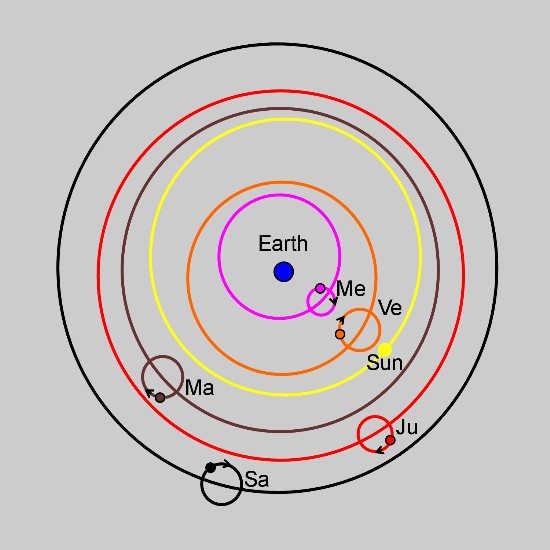

Fictitious Supercontinent Cycles
 
Fictitious Supercontinent Cycles |
 When
individuals seek to describe phenomena, events, or processes within the
framework of a problematic paradigm, the explanations proffered are generally
more complex, if not physically impossible, than subsequent, corresponding
explanations within a different, but more-correct paradigm. For example, in the
Earth-centered Ptolemaic universe paradigm, the apparent motion of planets, in
particular their retrograde motions, were described by complex epicycles, shown
at right. Within the now-known, more-correct paradigms, those and other
phenomena can be explained logically, causally, and with greater simplicity,
without invoking complex, ad hoc assumptions.
When
individuals seek to describe phenomena, events, or processes within the
framework of a problematic paradigm, the explanations proffered are generally
more complex, if not physically impossible, than subsequent, corresponding
explanations within a different, but more-correct paradigm. For example, in the
Earth-centered Ptolemaic universe paradigm, the apparent motion of planets, in
particular their retrograde motions, were described by complex epicycles, shown
at right. Within the now-known, more-correct paradigms, those and other
phenomena can be explained logically, causally, and with greater simplicity,
without invoking complex, ad hoc assumptions.
Geological literature contains a plethora of papers dealing with various aspects of so-called �supercontinent cycles�, also called �Wilson cycles�, the idea that before Pangaea, there were a series of supercontinents that each formed and then broke apart and separated before colliding again, re-aggregating, and suturing into a new supercontinent in a continuing sequence. J. Marvin Herndon has suggested that �supercontinent cycles� are artificial constructs, like epicycles, attempts to describe geological phenomena within the framework of problematic paradigms [1].
 In
the plate-tectonics/planetesimal paradigms, supercontinent cycles are thought to
be necessary to explain the existence of mountain chains that pre-date Pangaea,
which are thought to form exclusively by plate collisions. In Herndon's
different, new, indivisible geoscience paradigms of Earth's early formation as a
Jupiter-like gas giant and Whole-Earth Decompression Dynamics fold-mountain
formation is natural consequence of surface curvature adjustments to
decompression-increased Earth diameter [2], as illustrated in the demonstration
at right.
In
the plate-tectonics/planetesimal paradigms, supercontinent cycles are thought to
be necessary to explain the existence of mountain chains that pre-date Pangaea,
which are thought to form exclusively by plate collisions. In Herndon's
different, new, indivisible geoscience paradigms of Earth's early formation as a
Jupiter-like gas giant and Whole-Earth Decompression Dynamics fold-mountain
formation is natural consequence of surface curvature adjustments to
decompression-increased Earth diameter [2], as illustrated in the demonstration
at right.
Models of supercontinents engaged in hypothetical Wilson cycles typically make use of problematic paleomagnetic calculations. As Herndon has shown [3], whole-Earth decompression can lead to significant errors in magnetic paleo-latitude calculations. Moreover, paleo-pole calculations, used to imply continent rotations, are without meaning due to changes in Earth-diameter. No means of supercontinent locomotion, fold-mountain formation without the necessity of collisions, significant errors in magnetic paleo-latitude calculations, and the invalidity of magnetic paleo-pole calculations all together call into question the entire concept of supercontinent cycles. Fictitious supercontinent names, such as Rodinia, Columbia, and even Pangaea, will eventually pass into history along with planetary epicycles. The challenge for geologists will be to discover the true sequence of fragmentation beginning with Ottland and continuing to the present and to discover the nature of Earth�s surface throughout that progression.
| References | |
| 1. |
Herndon, J. M., Fictitious Supercontinent Cycles, Journal of Geography, Environment and Earth Science International, 2016, 7(1), 1-7. (click here for pdf) |
| 2. |
Herndon, J. M.,Origin of mountains and primary initiation of submarine canyons: the consequences of Earth's early formation as a Jupiter-like gas giant. Current Science, 2012, 102, 1370-1372. (click here for pdf) |
| 3. |
Herndon, J. M., Potentially significant source of error in magnetic paleolatitude determinations. Current Science, 2011, 101, 277-278. (click here for pdf) |
Return to Home Page NuclearPlanet.com